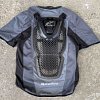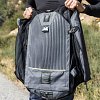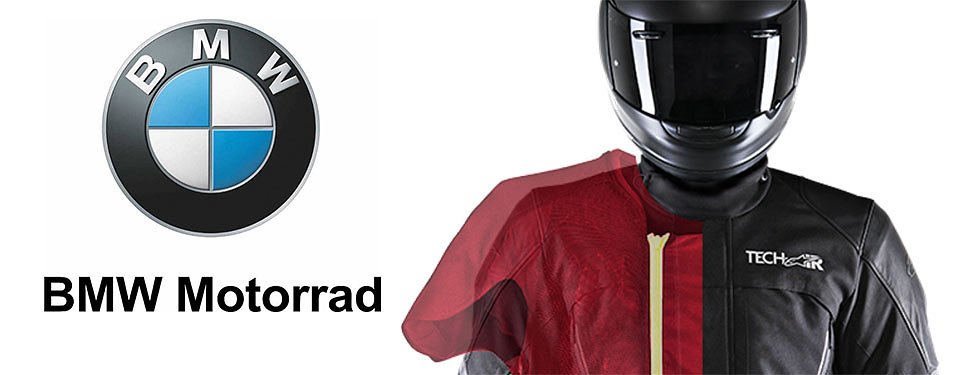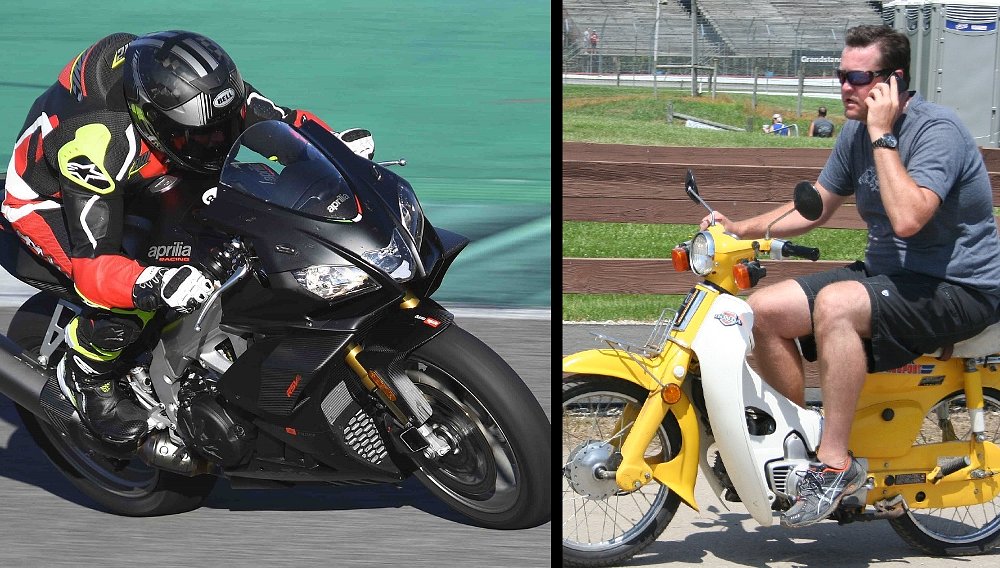Airbags in motorcycling, a brief history: At first it was only a fantasy, then about 15 years ago the technology trickled into the world of two wheels from, where else, the Mount Olympus of motorcycling. Yes, you needed a Gold Wing in order to have an airbag.
Eventually MotoGP riders had them built into their suits, and soon after so did racers all around the world (for a high price). In the past few years, companies have competed to offer versatility and affordability in airbag systems for street use, and now it seems the industry has scaled so that even we, the unwashed motorcycling masses, can protect ourselves the way car owners have since the 1980s. There have been many steps along the way — I know, I said the history was going to be brief. What’s arguably most important is the here and now.
Alpinestars Tech-Air 5 system is the latest example — a self contained, universal system that can be worn under almost any jacket and is designed to deploy before the rider’s first impact of a crash. That means there’s no tether to the motorcycle to trigger the system. Instead, it computes data a thousand times each second that it gathers from three accelerometers and three gyroscopes built into the integrated back protector. Tech-Air 5 in size XS can deploy quicker (20 milliseconds) than a 4XL (40 milliseconds), so figure for an average size of medium or large about 25 milliseconds. In other words, a little more than 1/50th of a second.
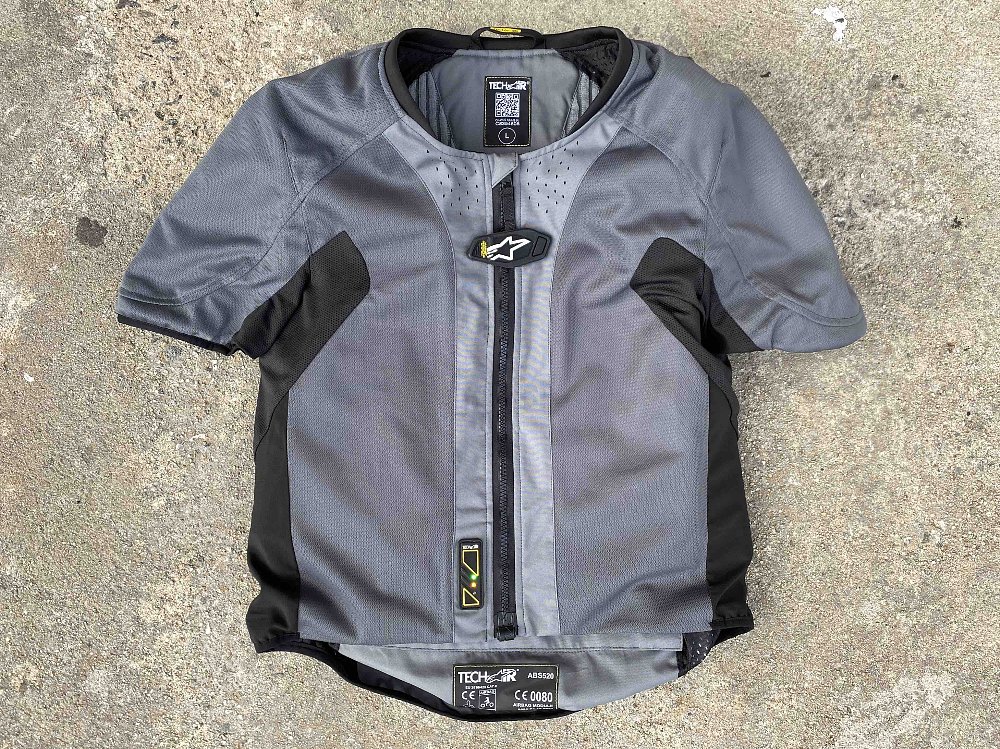
It’s built for the street rider; commuting, Sunday rides, road trips, et cetera. It has also been tested and approved for ADV use, and shouldn’t deploy with small tipovers or get-offs at low speed. If you plan to hit serious jumps in the dirt, that’s where the line is drawn: It can get confused in flight, or more accurately during landing, which offers a lot more force than typical street riding. It’s also not designed for a racetrack, where the Tech-Air Race system is meant to serve. The two systems use different algorithms, with the Race unit having slightly more versatility, since it can be programmed for the track or street, provided you have compatible gear.
As a society, we’ve come to accept that airbags in cars are good and improve safety, but do these airbag garments actually work? The short answer is yes (see this article at MotoGP.com showing data from one of Marc Márquez’s crashes). The reason they are mandatory in MotoGP isn’t because they’re cool or so that gear companies can sell more jackets. One third-party test that Alpinestars likes to cite is from the Swiss company SGS (issuer of CE certifications), which found that when the Tech-Air 5 system is deployed it offers the same protection provided by 18 CE1 back protectors. And yes, there are variables, as always. Someone could probably make a case that airbags in gear wouldn’t protect well against sharp objects, for example, but motorcycle accident injuries don’t typically involve a truck full of swords.
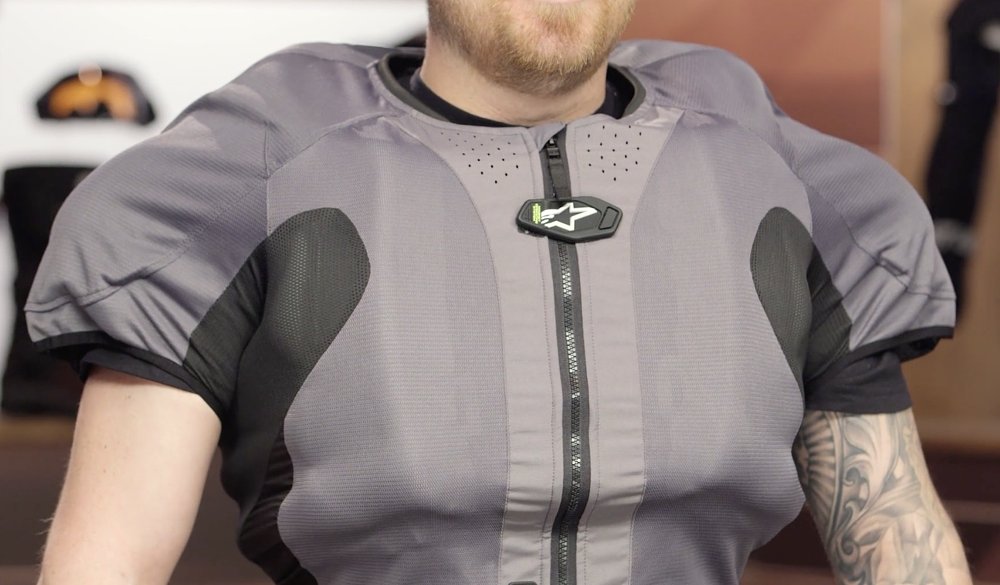
It might seem like the technology needed for a self-contained airbag unit came out of nowhere, because consumer-facing options have only blossomed in the past five or 10 years. That’s not true, though — Alpinestars (for example) has been collecting data and working on computations to map crashes for about 20 years. A dozen years ago we saw world-championship riders start using them, and about eight years ago a consumer could buy a full racing suit with a self-contained and integrated airbag system for around $5,000. Now, the Tech-Air 5 universal system for use on the street is available for about $700.
Those are the basics of how the system works and at what rate the airbags inflate. For a full rundown on specs, basic questions, and a video of it deploying, I recommend the product page.
My true curiosity with the Tech-Air 5 system relates to airbag garments like this in general. What’s it like to live with? Will it fit under jackets I already have? How often do I have to charge it? Does it breathe well enough in the heat? As someone who rides nearly everywhere I go, those were the questions I wanted to answer and I used the latest system with the most appealing specifications as a litmus test for the category.
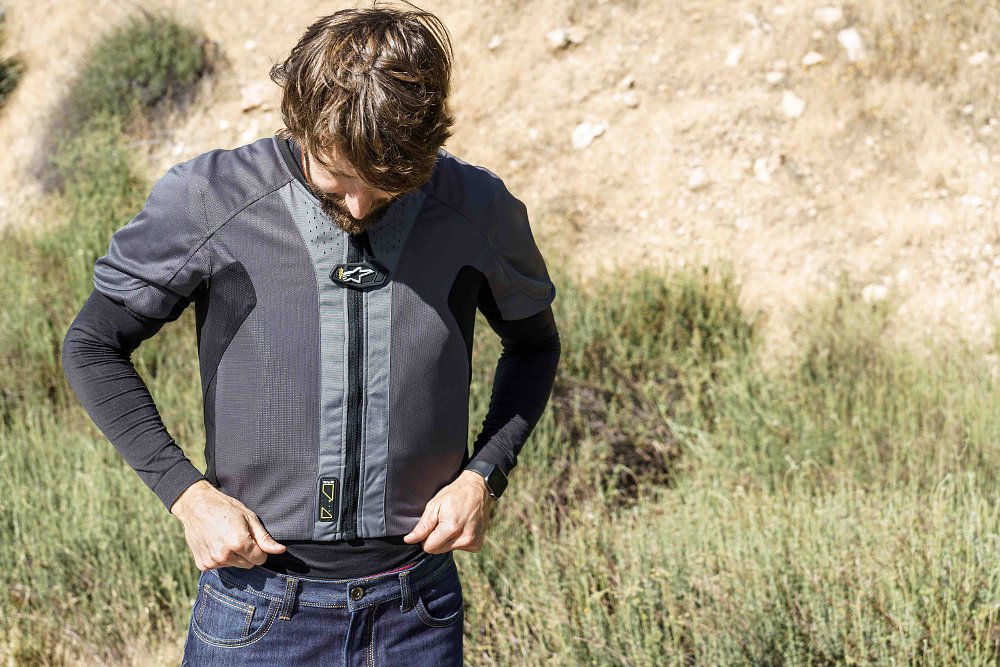
Living with an airbag in everyday riding
Before I even talk about how it fits, it’s worth discussing how it’s supposed to fit under a jacket. Other systems can or do go over the jacket, but for the Alpinestars system astute motorcyclists will understand that in order for this airbag to go off under a jacket there needs to be room between the rider’s body and their outer layer. (This is exactly why every other generation of Alpinestars airbag has needed to pair with a jacket that has stretch panels built in, like the race suits do, so that the bags have room to inflate.)
The official word for Tech-Air 5 is four centimeters of clearance around the rider’s torso for the bag to inflate, and it will inevitably turn into a judgement call. Many people’s jackets probably fit loosely enough, especially with the back protector removed, that the system will fit just fine. If a deep breath in makes your jacket skin tight, there probably isn’t enough room for the system to deploy. (This Alpinestars video goes into more detail about fitment.) As for what would happen if the system goes off in a jacket that’s too small, answers were hard to come by — reading between the lines it seems like the biggest concern is blowing out seams or otherwise ruining the jacket, not damage to the rider’s body.
Despite looking a little bulky and weighing a little over four pounds, the Tech-Air 5 is pretty comfortable. The main chassis material is light and flexible, and a nifty magnetic barrel makes sure the zipper is perfectly aligned every time. To turn it on, zip it up and attach the small tab across the sternum, which secures via a magnet and Velcro. The LED status lights near the bottom of the zipper will show the system booting up, and by the time I had my jacket on the Tech-Air 5 system was armed and ready to go. I often wear a backpack and was immediately concerned that it wouldn’t work, but it does. I never noticed the apparatus built into the back protector, even with a bag on, and from a safety standpoint I was told there’s no added risk due to the airbag inflating.
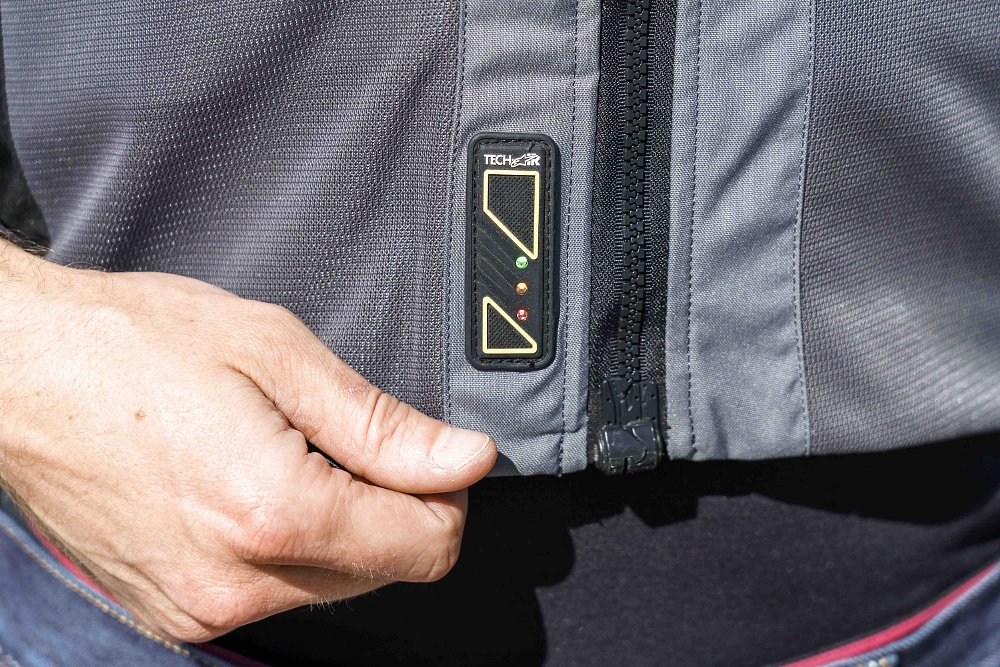
One of the most common questions I received from friends and social media about this system was, “Does it breathe in hot weather?” I took a multi-hour ride through the hottest temps I could find, between 85 and 90 degrees, and learned that the fabric does breathe pretty well, especially the black sections along the sides and armpits. Obviously, it helps if the jacket you choose has good ventilation in the chest, and incidentally this is why the hard-armor back protector is CE1, because it flows more air (CE certification goes up to CE2 when the airbag is deployed). However, at the end of the day it’s another piece of material between your skin and fresh air and it can get stuffy, especially at low or no speed.
That brings up another important point, which is that if you sweat in it you’re likely to stink it up or at least want to wash it. The built-in electronics don't separate from the chassis, so washing it is a delicate process that Alpinestars is still working on answering definitively. If it were my piece of apparel, I would use some sort of biodegradable soap so as not to damage the synthetic material, rinse the ‘pits carefully and then hang it somewhere to dry. One thing is clear, don’t hang it in the sun if you can avoid it; the fabric will last longer if it doesn’t get pummelled by UV rays.
While it’s drying you can take the time to check the app, which is more than a gimmick for the Tech-Air 5 system. It allowed me to check the battery level and map my ride, which is handy, but somewhat more crucially it allows the rider to power down remotely without having to take it off or disconnect anything.
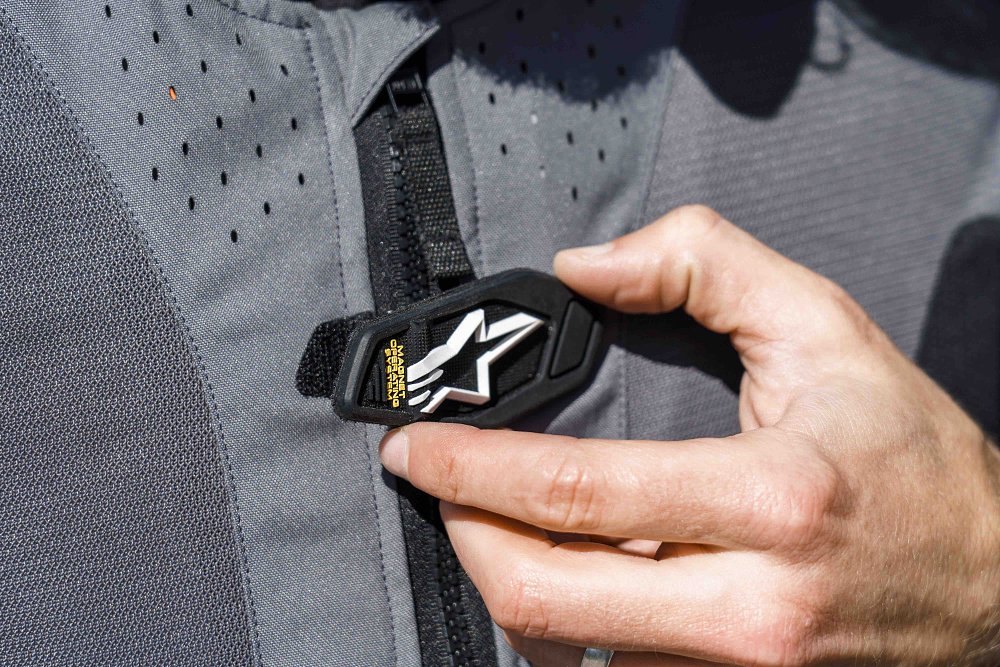
Odds and ends
Lots of people wanted to know about false deployments and the overall accuracy of the algorithm that determines if you have crashed or not. It’s a totally understandable concern to have, and it falls into a gray area that’s pretty hard to test, considering every situation is different. The system does double check itself before filling the airbags, so in most cases it should be able to tell the difference between an actual rear-end collision and your buddy bumping your back tire at an intersection. In the same vein, is it better than full armor? When it deploys, yes, and it has proven to be reliable, but there’s no denying that armor is more reliable in that it is always deployed, even if it’s less comfortable.
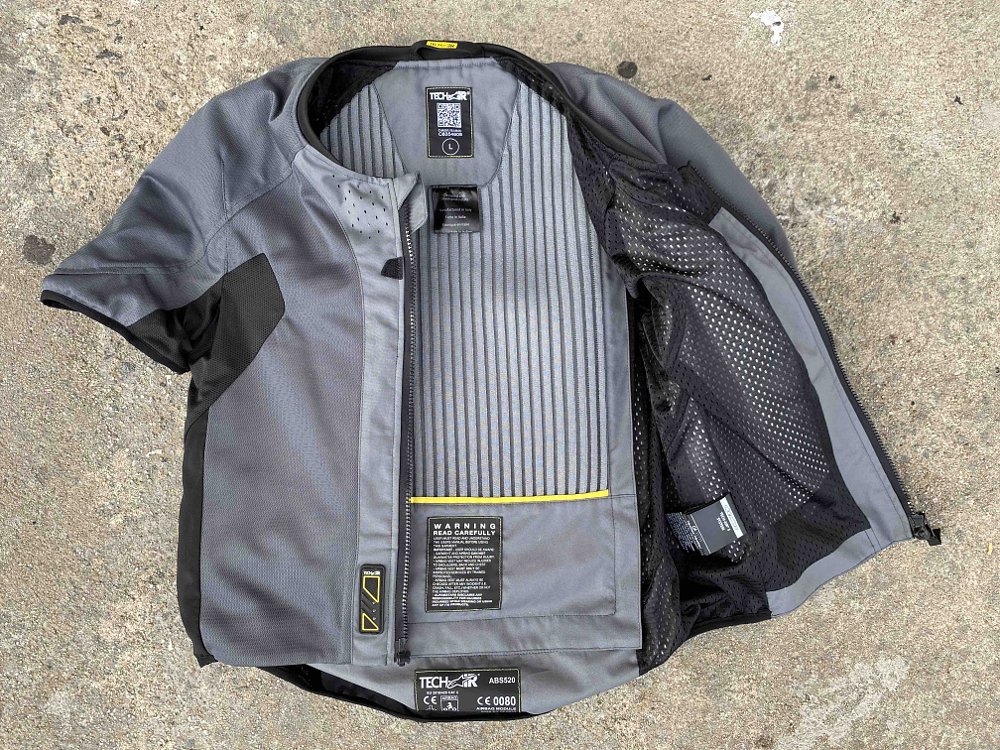
My goal was to test the technology practically, not create a buyer's guide. Still, naturally some riders wondered how this system compares to airbag solutions from Dainese, Helite, or Ixon. Dainese’s system can go over a jacket, which is a benefit in versatility, but the reaction time isn’t quite as quick (45 ms) and it isn’t always armed when the bike is stopped. Ixon’s product — made by French company In&Motion which also partners with Klim — has a lower financial barrier of entry initially, but then again it covers a little less of the body than this system. Tethered options have to separate from the machine in order to deploy, when a sensored system would have gone off; however, it’s a fail safe for those riders who are tired of chasing the latest tech. It’s going to come down to each individual motorcyclist, what they prioritize, and how much they value the pros and cons of each system.
If your ride does go pear-shaped and the Tech-Air 5 system goes off, one thing to know is that you’ll have to send the unit back to the Alpinestars mothership to get repacked, which rings in at $300 including fresh canisters. It’s apples to oranges but, for a bit of context, some quick research shows that price is comparable to replacing one airbag in a popular, generic car. (As of this article’s publish date, Alpinestars is still working through certifications slowed by COVID-19 and for the time being needs to replace the airbag for each deployment.)
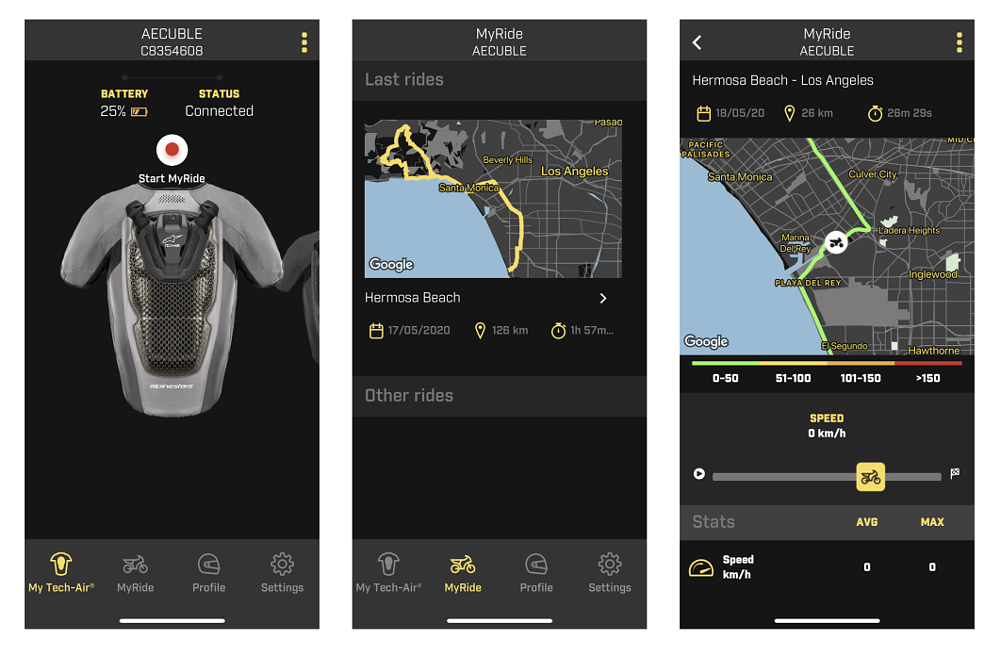
The bottom line
My complaints for this system are few and far between. I wish I could wash it, and I bet Alpinestars does, too, now that they have my test unit back, but I don’t see an obvious solution that doesn’t make it heavier, more complicated and expensive, or stifle breathability. Maybe Alpinestars realizes that we motorcyclists have been living in our own stench for generations, so it’s only natural. My only other note is that I hope the next generation offers two deployments before it needs to be recharged. I imagine a rider off on a multi-week road trip and setting it off with a small tip over on day two — it would be nice if that rider could continue on motel hopping across a continent knowing that there was still one more charge waiting in the wings.
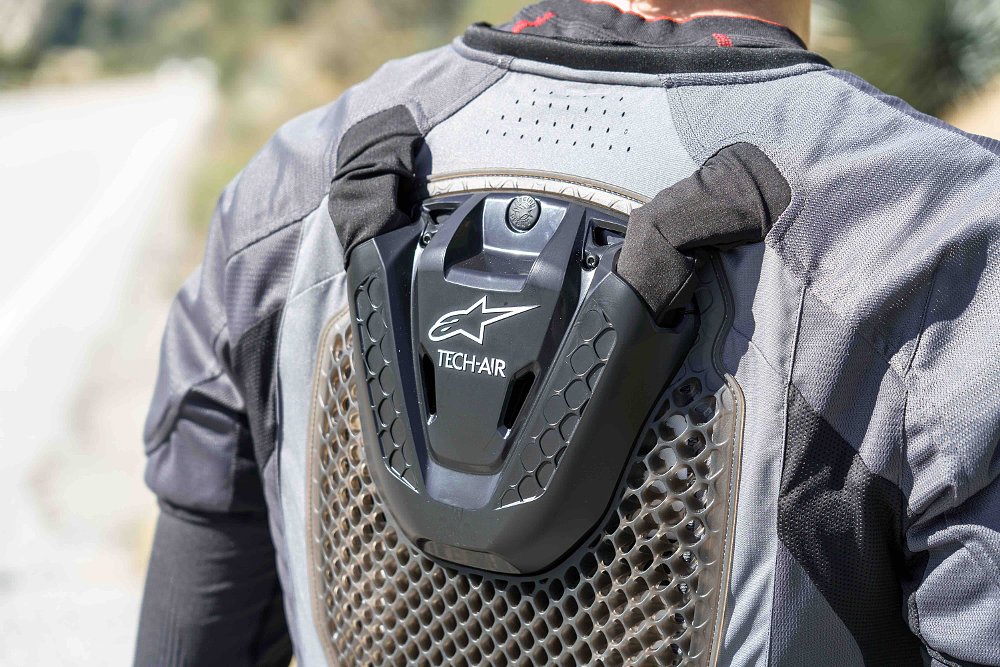
What I was hoping to determine by using this Tech-Air 5 system every time I rode for a couple of weeks was ease of use, and so far it’s the best solution I’ve seen for a daily ride. It takes four to six hours to charge fully and lasts for 30 hours of armed riding time. If you want to know how much juice is in the battery, check the app. If it’s so blasted hot that you’d rather just put the back protector in your jacket and leave the airbag system at home, do that. A modern universal airbag like this puts incredible safety technology within reach of everyday riders, without forcing any agenda, and I think that’s excellent.
Will I commit to it full time? The price is easily worth it if you can avoid one trip to the hospital for a busted collarbone or a cracked rib. I will admit that having seen and felt Tech-Air in action on a racetrack I have evolved to always reaching for my airbag-equipped suit when I test a high-horsepower machine on a closed course. Slinging on another layer for my commute is the next logical step.

 Membership
Membership




